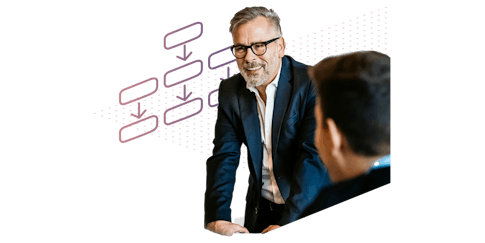How to Achieve Sales Productivity in a Portfolio Company
Improving win rate

As Recently as 2018, Private Equity (PE) Deal Volumes Reached a New High of $1.4 Trillion
This surge is coming at a time when the deal count has not meaningfully increased in the last four years. These numbers suggest that an increasing amount of capital is chasing the same opportunities. As a result, PE acquisitions are commanding higher prices.
Subsequently, PE firms face significant challenges in the push to create returns from acquisitions purchased at high multiples. Compounding this challenge is the fact that many of these transactions involve companies that have already experienced one or two cycles through PE ownership. The potential returns that come from cutting excess costs have long since been exhausted. Revenue growth through increased sales and marketing productivity is now the primary route to enhanced levels of profit and margin expansion.
However, creating an engine that delivers predictable revenue growth often seems elusive. In our work with financial sponsors and operating partners, frustrations abound. Portfolio management frequently struggles to explain why forecasts are missed or sales opportunities are delayed. CRM data quality or conflicting financial information are blamed for the lack of progress. Root causes are poorly understood, and the path forward is seldom clear.
However, those who solve these growth issues reap considerable rewards. When installed and configured correctly, this revenue engine not only fuels growth essential to enhanced levels of EBITDA but also creates predictable revenue. This revenue confidence elevates potential sales, multiples and creates significant enterprise value.
Consistent and dependable revenue growth emerges from a focus on the right people, processes, and tools. Based on our 10+ years of experience with PE firms and their portfolio companies, we’ve identified the following three steps to building this revenue engine.
Standardise the Sales Process Across the Portfolio Company
Start by ensuring that every selling activity creates value for your customer and for your organisation. The actions of most sales teams are a function of the habits and work experiences within the sales organisation. Most sales teams lack the rigour of having tightly defined selling actions for each stage of the customer’s buying journey. Enhanced levels of productivity come when the entire sales organisation adheres to a standardised sales process, one that has been intentionally and thoughtfully developed with the customers’ buying journey in mind.
Ask yourself: What are the needs of your buyer personas? How do these needs change as they move from early awareness of a business issue or opportunity to evaluating response options, searching and selecting vendors, and ultimately procuring a solution? Does your sales team understand how these needs change and how this should drive the sales professional’s cadence and actions?
Mapping clear, specific activities that are verifiable by identified customer actions ensures that the sales professional’s time is invested where it matters most. Creating a standard against which leaders can inspect and coach through high-impact coaching questions creates rigour and eliminates ineffective selling time. Moreover, when this process is tied to a CRM system, sales professionals can benefit from insights backed by data, and managers enjoy enhanced forecast accuracy. By standardising the process, leaders will:
- Create a consistent selling approach aligned to the customer's buying process
- Isolate ineffective selling activities
- Generate more accurate forecasting through improved management rigour
- Introduce objective milestones and standards for pipeline management
- Increase sales productivity
The benefits of a standardised sales process across the portfolio company are substantial. Consider research from McKinsey, which shows that customers trust businesses that deliver a consistent experience 30% more than those that are inconsistent.
How to Do It
Standardising the sales process begins with a collaborative consulting engagement in which stakeholders identify the customer buying journey, their needs, and the selling practises that drive the most value. The consulting process should include developing a project plan, conducting discovery interviews, and planning how the process will be communicated to the team.
This flexible, scalable plan must:
- Educate sales professionals on modern buying behaviour
- Provide sales professionals with the specific, actionable, and measurable activities for each stage of the sales/buying process to help guide prospective customers in their decision to purchase
- Create a framework in which the sales professional co-creates solutions with customers
The result is an experience in which value is differentiated not only at the product and service level but also in the way the sales professionals engage with the customers. Consider research from Forrester, which found that 77% of surveyed buyers want interactions from sales professionals that help them learn something new.
A formal sales process delivers these outcomes by overlying structure onto selling challenges. A codified, step-by-step approach offers guidance that frees sales professionals to place their focus where it is needed most: the customer’s challenge. It’s not surprising to learn that “representatives who adopt and are managed against a structured sales methodology are the ones who close their deals the quickest — accelerating revenue,” according to Accenture’s analysis of companies with $1 billion or more in annual sales revenue.
The process must address the complete scope of the sales cycle, including pre-call planning, opening and positioning, customer conversations, value analysis, follow-up, negotiations, and closing. The sub-components of each step will differ from one organisation to another because different products and services present different selling challenges. A sales process can always be modified. What is important is that the selling organisation has one and follows the cadence.
Accelerate Skill Adoption and Align Skills to the Strategy
Part two of the revenue engine addresses how the defined selling actions will be executed. Driving high levels of proficiency in interpersonal selling skills creates a differentiated experience for customers when interacting with the selling organisation.
Additionally, pacing matters when driving skill adoption. The reason: quick skill adoption generates early results, which positions the PE firm to realise the potential value of the portfolio company faster. Moreover, accelerating skill adoption minimises the time out of market demanded during instructor-led sales training.
Advancing this process will enable leaders to:
- Drive engagement that translates to revenue
- Reduce the sales cycle
- Reduce turnover due to higher levels of plan attainment
Taking steps to accelerate skill growth moves the portfolio company closer to measurable and rewarding outcomes. Research from Gallup illustrates just how expansive those rewards can be. In their review of 49,495 business units with 1.2 million employees across 22 organisations, they discovered that those who focus on building employee skills realise a 10% to 19% increase in sales and 14% to 29% increase in profit.
How to Do It
Identify the skills that most closely correlate to the growth strategy of the organisation. Creating demand from newly sourced clients as a revenue driver requires a different set of skills than, for example, increasing conversion rates from an existing pipeline. Begin by understanding which skills have the potential for the most immediate impact on your growth strategy.
Additionally, accelerating skill adoption requires coaching. When leaders commit to a consistent coaching cadence, they demonstrate their commitment to change and their vested interest in seeing sales professionals improve. Effective coaching means giving sales professionals guidance to embed best practises into their daily work. This approach to skill development ensures that the training survives into the field where skills can generate results. Choose a limited number of new skills, be specific, provide immersive hands-on training experiences with a lot of practise time, and equip your managers to coach to the desired skills.
Regular communication provides the coach with more visibility into things like pipeline assessment, deal qualification, future business forecasts, the strength of sale analysis, and early detection of potential problems with a sale. This detail enables an in-depth measurement process, which leads to more predictable revenue streams. More importantly, measurement also leads to larger revenue streams. Research from Bain shows that metric-driven initiatives “increase profitability by as much as 25% over sustained periods” for sales organisations.
It is easy to see why this finding is true given that coaching instills a shared sense of achievement. As sales professionals see the measurable outcomes from coaching, they develop a greater buy-in to the value coaching offers. This buy-in is critical because it leads to engagement, and engaged employees “produce better business outcomes than other employees — across industry, company size, and nationality, and in good economic times and bad,” according to Gallup data collected from more than 195,600 US employees.
Equip Sellers, Managers, and Change Leaders With Tools That Deliver Data-Driven Insights
Modern sales transformation initiatives leverage technology that guides progress
and informs each stakeholder about that progress along the way. This approach
begins by establishing baselines for activity and skill proficiency. Next, leaders must
visually represent changes in knowledge and proficiency to engage sellers in their own
development.
Measurement like this is increasingly important given that the average annual sales training spending per person has reached $2,326, according to the Association for Talent Development.
Effective measurement guides the training process as it unfolds. Sales professionals discover where they need to focus their attention and where their blind spots reside. Measurement is for the learner as much as it is for the leadership. Additionally, analytics ensure that the leader’s and the sales professional’s time is being invested in the right areas. Success comes from:
- Guiding managers on who to coach, what to coach, and when to coach
- Informing change leaders on engagement and reaction data for all aspects of the change programme
- Capturing real-time changes in operational metrics that align to your growth strategy to quantify economic impact
How to Do It
Sales professionals, managers, and change leaders can leverage a range of metrics to ensure the effectiveness of training. For example, a metric like engagement seeks to answer how learners are progressing through training. To answer this question, the leader must know what portion of the team is enrolled in training. Engagement is ongoing. Therefore, engagement is an ever-present characteristic of training effectiveness.
However, enrolment alone does not signify engagement. Leaders must go further
to capture the engagement picture by drilling down to other factors. For example,
progression tracks the participant’s progress toward a key learning milestone. Frequency
measures a learner’s rate of engagement by revealing how many days have elapsed
between learning sessions.
Other metrics like experience ask how memorable training is and how excited learners are to participate. The experience of learning matters because it drives adoption. Measurements in this category can include net promoter score, course rating, confidence, qualitative sentiment, and commitment to change. Measuring experience gives leaders the information they need to make the adjustments that ensure skills will translate from learning to real selling situations.
Finally, effect asks if training has improved business outcomes and skill adoption.
Participants will be more committed to the process if they can see a clear line connecting
the material in training to skills they believe will create success in their careers. Many
use the Kirkpatrick Model to measure effect. With this approach, training effectiveness is
gauged across four key areas: engagement, behaviour change, knowledge retention, and
business results.

Richardson's Connected Selling Curriculum
Richardson's Connected Selling Curriculum enables your team to develop your sellers against role-based competencies aligned to your business needs while achieving consistency at scale.
Learn MoreTaking the Next Step
Elevating the value of a portfolio company means investing in a standardised, accelerated, and data-driven sales methodology.
At Richardson Sales Performance, we offer a structured, connected selling curriculum. Our suite of instructor-led training, digital learning solutions, and enablement tools provide an end-to-end solution that standardises selling skills across the business, accelerates skill adoption, and maintains outcomes.

Get industry insights and stay up to date, subscribe to our newsletter.
Joining our community gives you access to weekly thought leadership to help guide your planning for a training initiative, inform your sales strategy, and most importantly, improve your team's performance.






